Regional Sea Level Changes in the East China Sea from 1993 to 2020 Based on Satellite Altimetry
Abstract
:1. Introduction
2. Study Area, Adopted Datasets, and Methods
2.1. Study Area
2.2. Adopted Datasets
2.3. Processing Methods
2.3.1. Analysis of ECS Sea Level Change Based on Local Mean Decomposition Method
2.3.2. Regional Averaging Method
2.3.3. Wavelet Analysis
2.3.4. Nonstationary Sliding Correlation Analysis Method
2.3.5. Empirical Orthogonal Function (EOF) Method
3. Results and Analysis
3.1. Annual Variations of ECS Sea Level Change
3.2. Seasonal Variations of ECS Sea Level Change
3.3. Modal Analysis of ECS Regional Mean Sea Level Change
4. Conclusions
Author Contributions
Funding
Institutional Review Board Statement
Informed Consent Statement
Data Availability Statement
Conflicts of Interest
References
- Qu, Y.; Jevrejeva, S.; Jackson, L.; Moore, J.C. Coastal Sea level rise around the China Seas. Glob. Planet. Chang. 2019, 172, 454–463. [Google Scholar] [CrossRef]
- Nicholls, R.; Cazenave, A. Sea-level rise and its impact on coastal zones. Science 2010, 328, 1517–1520. [Google Scholar] [CrossRef]
- IPCC. Climate Change 2013. The Physical Science Basis: Working Group I Contribution to the Fifth Assessment Report of the Intergovernmental Panel on Climate Change; Cambridge University Press: Cambridge, UK, 2014. [Google Scholar]
- IPCC. Climate Change 2021: The Physical Science Basis. Contribution of Working Group I to the Sixth Assessment Report of the Intergovernmental Panel on Climate Change; Masson-Delmotte, V., Zhai, P., Pirani, A., Connors, S.L., Péan, C., Berger, S., Caud, N., Chen, Y., Goldfarb, L., Gomis, M.I., Eds.; Cambridge University Press: Cambridge, UK; New York, NY, USA, 2021. [Google Scholar] [CrossRef]
- Siegert, M.; Alley, R.; Rignot, E.; Englander, J.; Corell, R. Twenty-first century sea-level rise could exceed IPCC projections for strong-warming futures. One Earth 2020, 3, 691–703. [Google Scholar] [CrossRef]
- Xu, Y.; Lin, M.; Zheng, Q.; Ye, X.; Li, J.; Zhu, B. A study of long-term sea level variability in the East China Sea. Acta Oceanol. Sin. 2015, 34, 109–117. [Google Scholar] [CrossRef]
- Hu, Z.; Yang, S.; Wu, R. Long-term climate variations in China and global warming signals. J. Geophys. Res. Atmos. 2003, 108, D19. [Google Scholar] [CrossRef]
- Wang, J.; Gao, W.; Xu, S.; Yu, L. Evaluation of the combined risk of sea level rise, land subsidence, and storm surges on the coastal areas of Shanghai, China. Clim. Chang. 2012, 115, 537–558. [Google Scholar] [CrossRef]
- Chen, X.; Zong, Y. Major impacts of sea-level rise on agriculture in the Yangtze delta area around Shanghai. Appl. Geogr. 1999, 19, 69–84. [Google Scholar] [CrossRef]
- Church, J.; Godfrey, J.; Jackett, D.; McDougall, T.J. A model of sea level rise caused by ocean thermal expansion. J. Clim. 1991, 4, 438–456. [Google Scholar] [CrossRef]
- Pokhrel, Y.; Hanasaki, N.; Yeh, P.; Yamada, T.J.; Kanae, S.; Oki, T. Model estimates of sea-level change due to anthropogenic impacts on terrestrial water storage. Nat. Geosci. 2012, 5, 389–392. [Google Scholar] [CrossRef]
- Zuo, J.; He, Q.; Chen, C.; Chen, M.X.; Xu, Q. Sea level variability in East China Sea and its response to ENSO. Water Sci. Eng. 2012, 5, 164–174. [Google Scholar]
- Jevrejeva, S.; Grinsted, A.; Moore, J.; Holgate, S. Nonlinear trends and multiyear cycles in sea level records. J. Geophys. Res. Ocean. 2006, 111, C9. [Google Scholar] [CrossRef]
- Zhou, X.; Zheng, J.; Doong, D.; Demirbilek, Z. Sea level rise along the East Asia and Chinese coasts and its role on the morphodynamic response of the Yangtze River Estuary. Ocean Eng. 2013, 71, 40–50. [Google Scholar] [CrossRef]
- Liu, X.; Liu, Y.; Guo, L.; Rong, Z.; Gu, Y.; Liu, Y. Interannual changes of sea level in the two regions of East China Sea and different responses to ENSO. Glob. Planet. Chang. 2010, 72, 215–226. [Google Scholar] [CrossRef]
- Cheng, Y.; Plag, H.; Hamlington, B.; Xu, Q.; He, Y. Regional sea level variability in the Bohai sea, Yellow sea, and East China Sea. Cont. Shelf Res. 2015, 111, 95–107. [Google Scholar] [CrossRef]
- Qu, Y.; Jevrejeva, S.; Williams, J.; Moore, J.C. Drivers for seasonal variability in sea level around the China seas. Glob. Planet. Chang. 2022, 213, 103819. [Google Scholar] [CrossRef]
- Yan, M.; Zuo, J.; Du, L.; Li, L.; Li, P.L. Sea level variation/change and steric contributions in the East China Sea. In Proceedings of the ISOPE International Ocean and Polar Engineering Conference, Lisbon, Portugal, 1–6 July 2007; Volume ISOPE-I-07-129. [Google Scholar]
- Wang, G.; Kang, J.; Yan, G.; Han, G.; Han, Q. Spatio-temporal variability., sea level in the East China Sea. J. Coast. Res. 2015, 73, 40–47. [Google Scholar] [CrossRef]
- Church, J.; Clark, P.; Cazenave, A.; Gregory, J.M.; Jevrejeva, S.; Levermann, A.; Merrifield, M.A.; Milne, G.A.; Nerem, R.S.; Nunn, P.D.; et al. Sea Level Change; PM Cambridge University Press: Cambridge, UK, 2013. [Google Scholar]
- Cazenave, A.; Llovel, W. Contemporary sea level rise. Annu. Rev. Mar. Sci. 2010, 2, 145–173. [Google Scholar] [CrossRef]
- Carson, M.; Köhl, A.; Stammer, D.; Slangen, A.B.A.; Katsman, C.A.; van de Wal, R.S.W.; Church, J.; White, N. Coastal sea level changes, observed and projected during the 20th and 21st century. Clim. Chang. 2016, 134, 269–281. [Google Scholar] [CrossRef]
- Cazenave, A.; Henry, O.; Munier, S.; Delcroix, T.; Gordon, A.L.; Meyssignac, B.; Llovel, W.; Palanisamy, H.; Becker, M. Estimating ENSO influence on the global mean sea level, 1993–2010. Mar. Geod. 2012, 35 (Suppl. S1), 82–97. [Google Scholar] [CrossRef]
- Shepherd, A.; Wingham, D. Recent sea-level contributions of the Antarctic and Greenland ice sheets. Science 2007, 315, 1529–1532. [Google Scholar] [CrossRef]
- Zemp, M.; Huss, M.; Thibert, E.; Eckert, N.; McNabb, R.W.; Huber, J.; Barandun, M.; Machguth, H.; Nussbaumer, S.U.; Gärtner-Roer, I.; et al. Global glacier mass changes and their contributions to sea-level rise from 1961 to 2016. Nature 2019, 568, 382–386. [Google Scholar] [CrossRef]
- Smith, J. The local mean decomposition and its application to EEG perception data. J. R. Soc. Interface 2005, 2, 443–454. [Google Scholar] [CrossRef] [PubMed]
- Cazenave, A.; Dominh, K.; Gennero, M.; Ferret, B. Global mean sea level changes observed by Topex-Poseidon and ERS-1. Phys. Chem. Earth 1998, 23, 1069–1075. [Google Scholar] [CrossRef]
- Dong, X.; Huang, C. Monitoring Global Mean Sea Level Variation with TOPEX/Poseidon Altimetry. J. Geod. Geoinf. Sci. 2000, 3, 266–272. [Google Scholar]
- Nerem, R.S. Measuring Global Mean Sea Level Variations Using TOPEX/Poseidon Altimeter Data. J. Geophys. Res. 1995, 100, 25135–25151. [Google Scholar] [CrossRef]
- Shafieloo, A.; Souradeep, T.; Manimaran, P.; Panigrahi, P.K.; Rangarajan, R. Features in the primordial spectrum from WMAP: A wavelet analysis. Phys. Rev. D 2007, 75, 123502. [Google Scholar] [CrossRef]
- Torrence, C.; Compo, G. A practical guide to wavelet analysis. Bull. Am. Meteorol. Soc. 1998, 79, 61–78. [Google Scholar] [CrossRef]
- Rodríguez-Fonseca, B.; Suárez-Moreno, R.; Ayarzagüena, B.; López-Parages, J.; Gómara, I.; Villamayor, J.; Mohino, E.; Losada, T.; Castaño-Tierno, A. A review of ENSO influence on the North Atlantic. A non-stationary signal. Signal. Atmos. 2016, 7, 87. [Google Scholar]
- He, S.; Wang, H. Oscillating relationship between the East Asian winter monsoon and ENSO. J. Clim. 2013, 26, 9819–9838. [Google Scholar] [CrossRef]
- Geng, X. Decadal and Subseasonal Variations of ENSO Impacts on the East Asian Winter Climate and Their Mechanisms. D. Nanjing University of Information Science and Technology: Nanjing, China, 2018. [Google Scholar]
- Hannachi, A.; Jolliffe, I.; Stephenson, D. Empirical orthogonal functions and related techniques in atmospheric science: A review. Int. J. Climatol. A J. R. Meteorol. Soc. 2007, 27, 1119–1152. [Google Scholar] [CrossRef]
- Weare, B.; Nasstrom, J. Examples of extended empirical orthogonal function analyses. Mon. Weather Rev. 1982, 110, 481–485. [Google Scholar] [CrossRef]
- Lombard, A.; Cazenave, A.; DoMinh, K.; Cabanes, C.; Nerem, R.S. Thermosteric sea level rise for the past 50 years; comparison with tide gauges and inference on water mass contribution. Glob. Planet. Chang. 2005, 4, 303–312. [Google Scholar] [CrossRef]
- Kawabe, M. Inter-annual Variations of Sea Level at the Nansei Islands and Volume Transport of the Kuroshio Due to Wind Changes. J. Oceanogr. 2001, 2, 189–205. [Google Scholar] [CrossRef]
- Chang, L.; Tang, H.; Yi, S.; Sun, W. The trend and seasonal change of sediment in the East China Sea detected by GRACE. Geophys. Res. Lett. 2019, 46, 1250–1258. [Google Scholar] [CrossRef]
- Bowen, M.M. Wind-driven and steric fluctuations of sea surface height in the southwest Pacific. Geophys. Res. Lett. 2006, 33, 14. [Google Scholar] [CrossRef]
- Chen, J.; Shum, C.K.; Wilson, C.R.; Chambers, D.P.; Tapley, B.D. Seasonal sea level change from Topex/Poseidon observation and thermal contribution. J. Geod. 2000, 73, 638–647. [Google Scholar] [CrossRef]
- Zhang, S.; Du, L.; Wang, H.; Jiang, H. Regional sea level variation on interannual timescale in the East China Sea. Int. J. Geosci. 2014, 5, 1405–1414. [Google Scholar] [CrossRef]
- Jo, S.H.; Moon, J.H.; Kim, T.; Song, Y.T.; Cha, H. Interannual modulation of kuroshio in the East China Sea over the past three decades. Front. Mar. Sci. 2022, 9, 909349. [Google Scholar] [CrossRef]
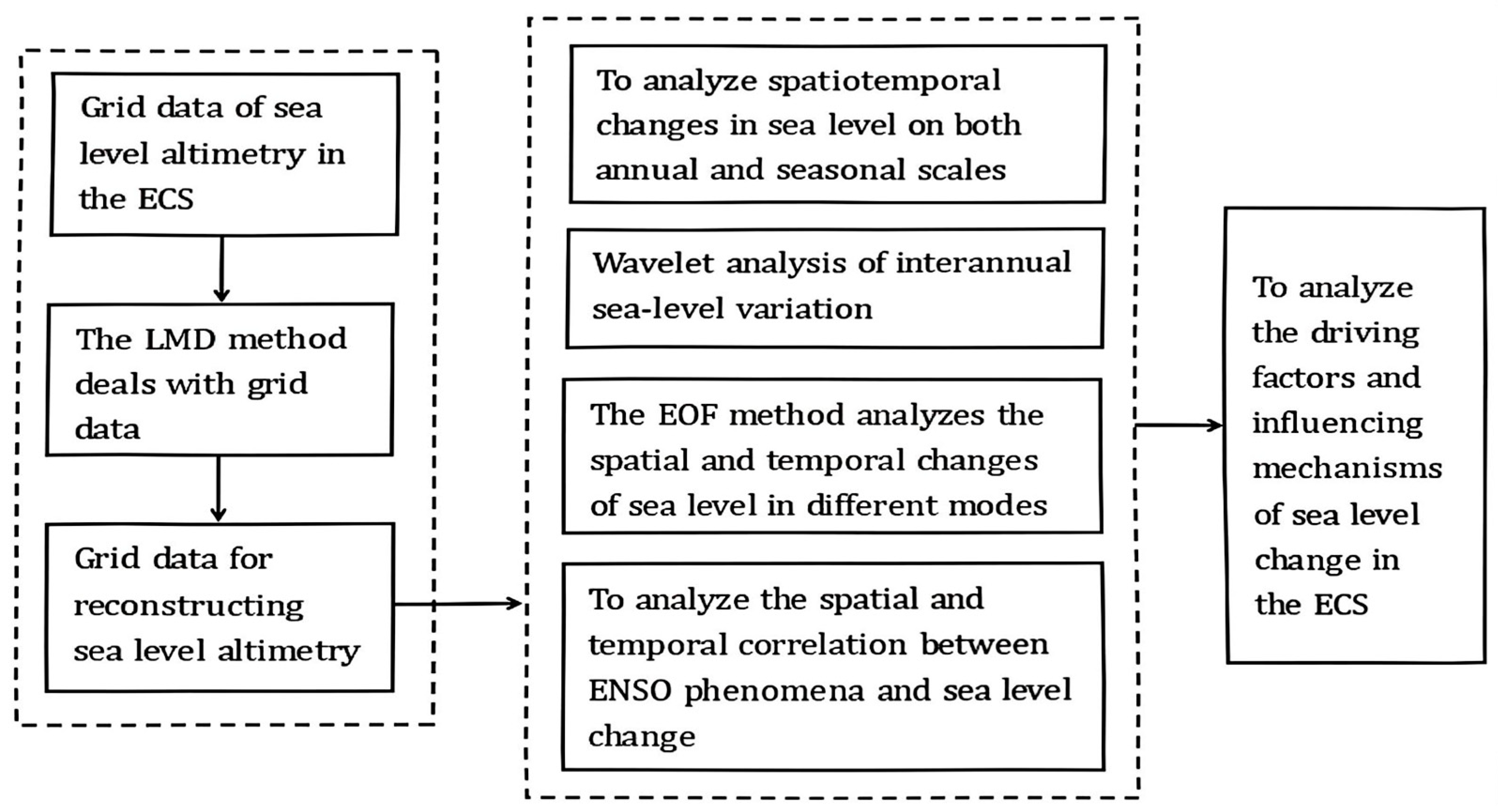
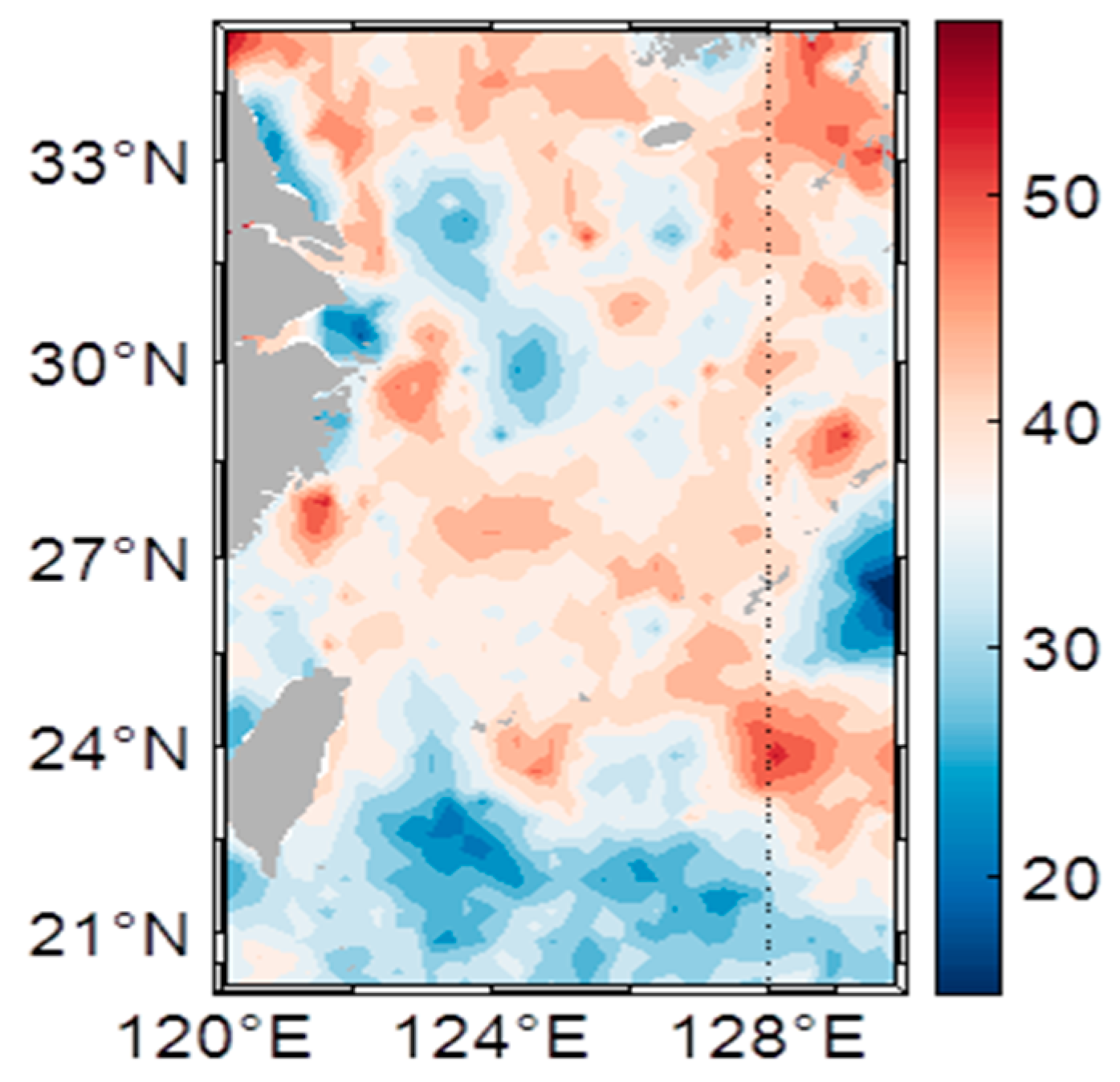
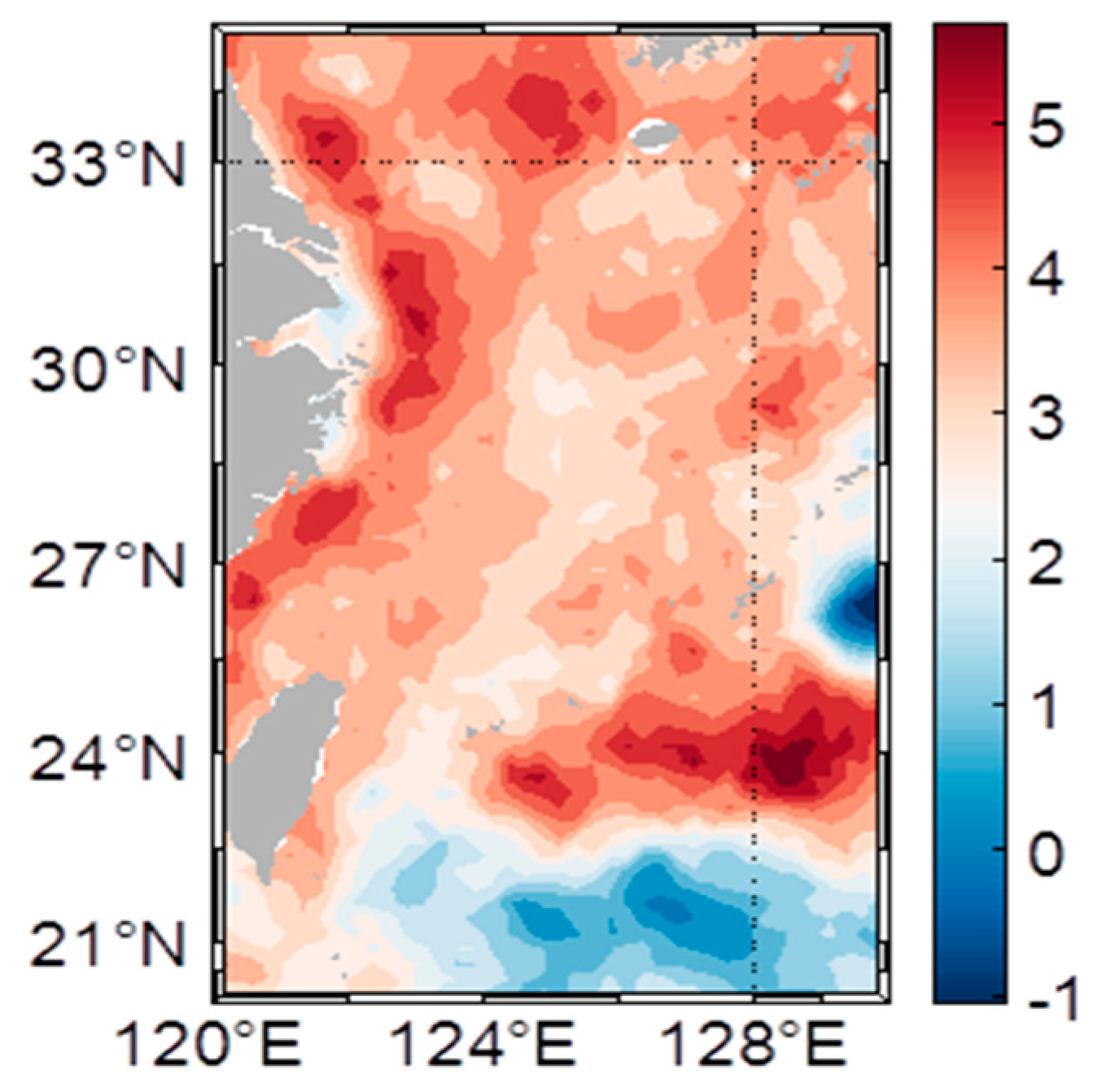
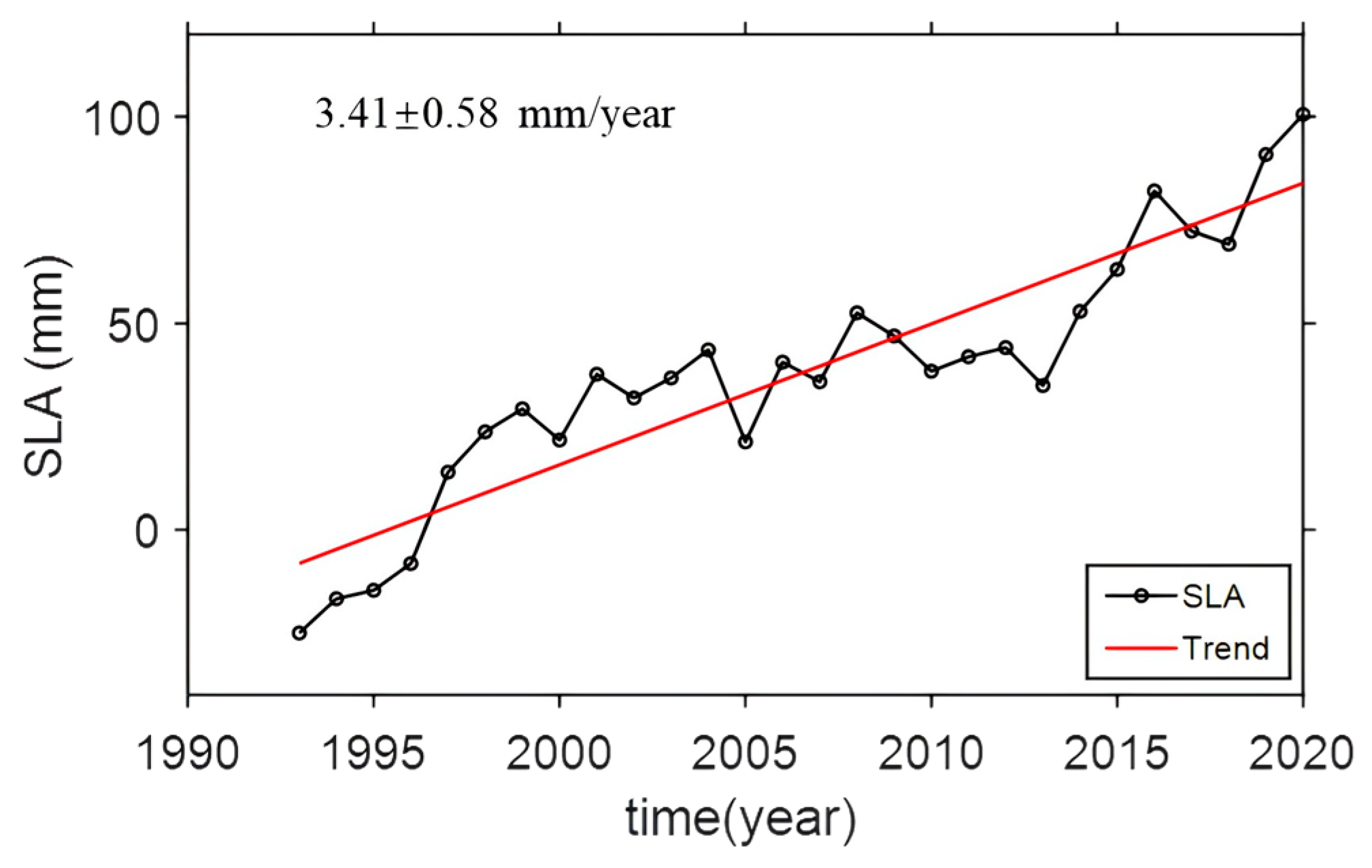


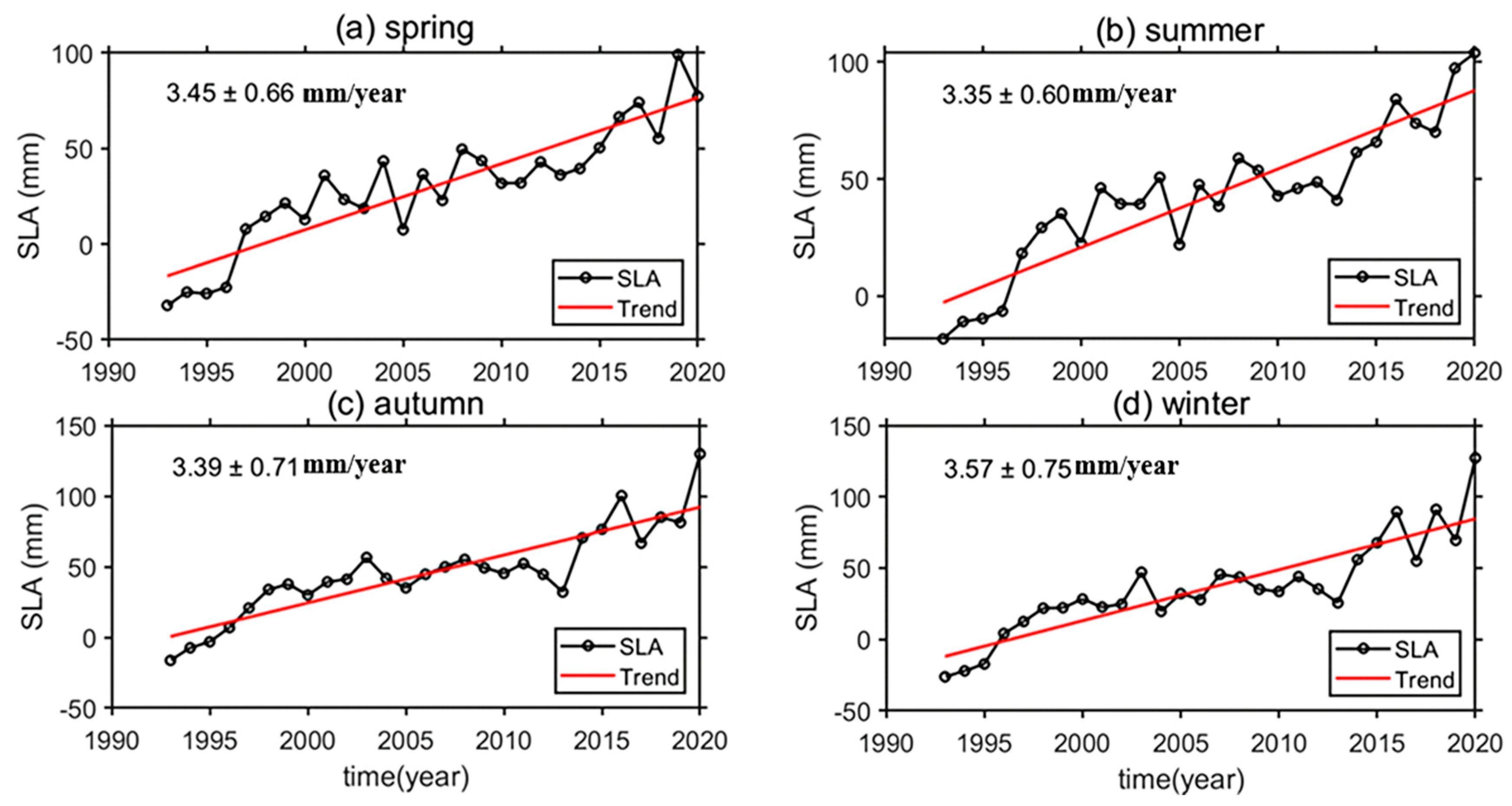
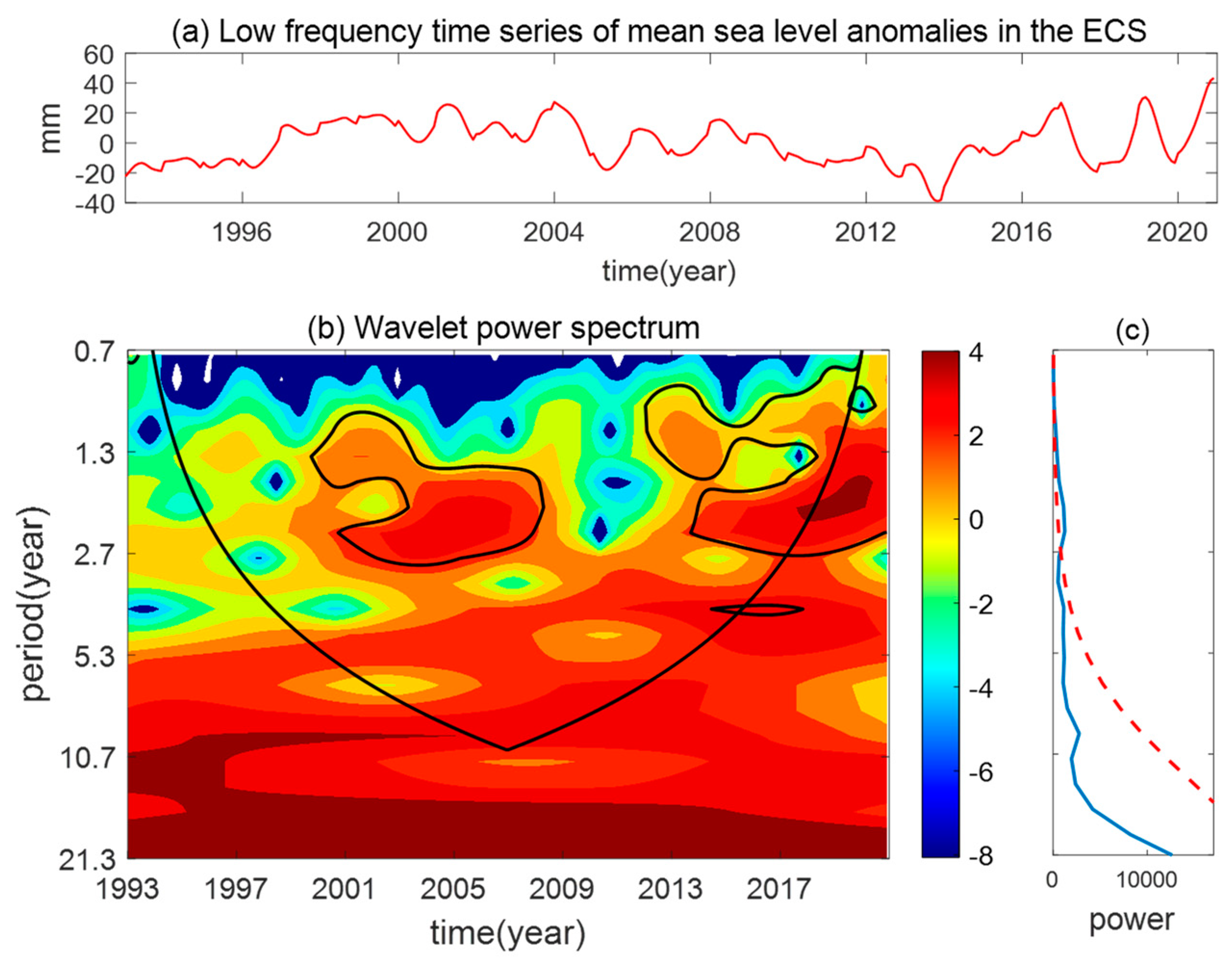
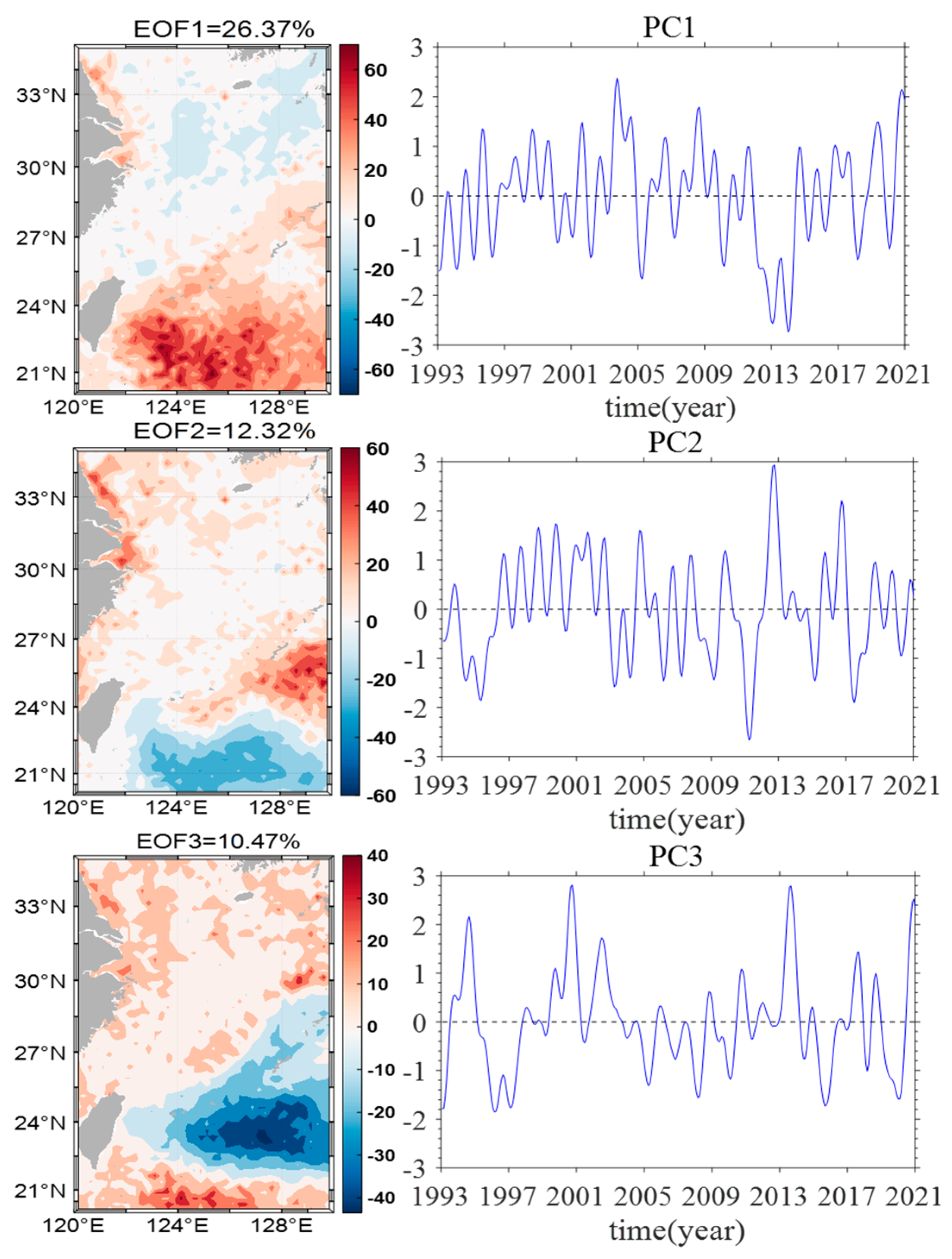
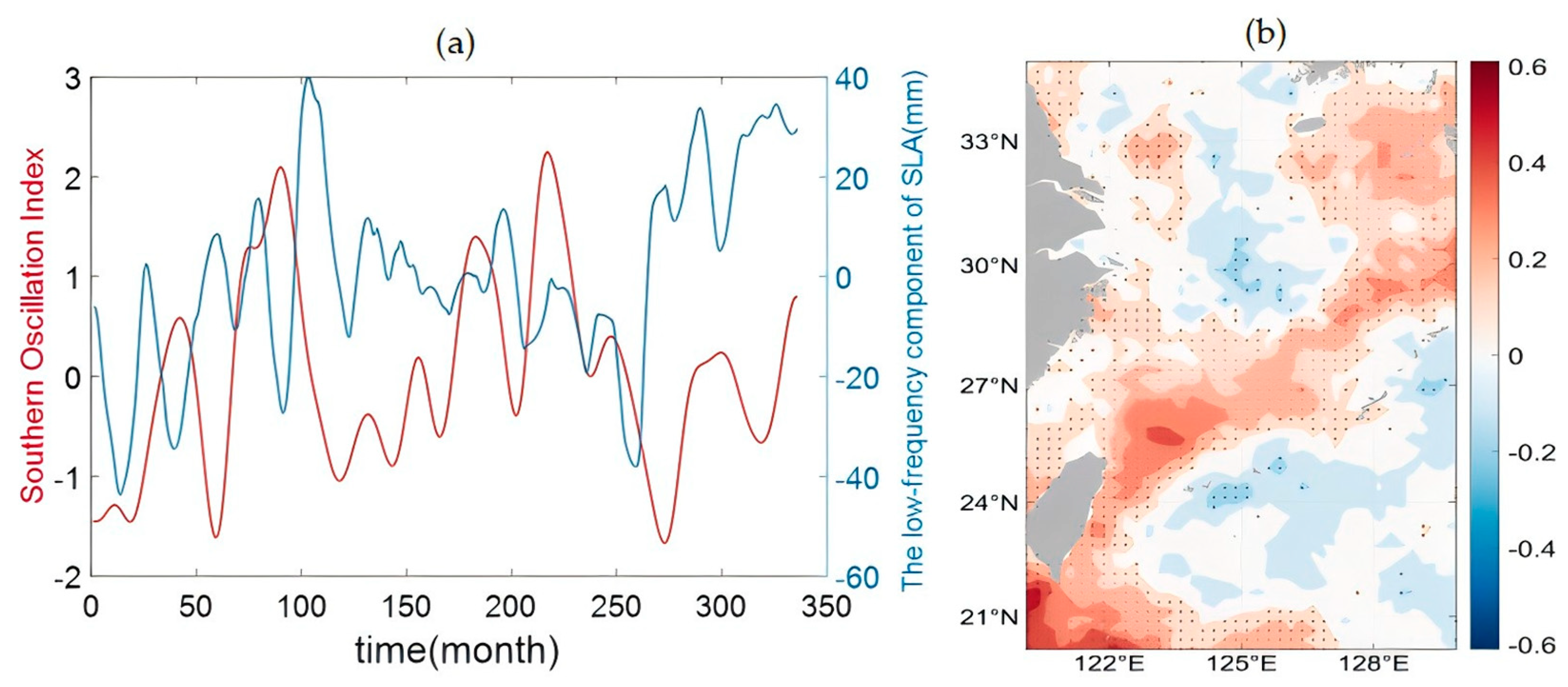
| Seasons | Linear Trend (mm/year) | Annual Amplitude (mm) | Mean Change (mm) | Acceleration (mm/year2) |
|---|---|---|---|---|
| Spring | 3.45 ± 0.66 | 131.22 | 29.94 | −0.08 |
| Summer | 3.35 ± 0.60 | 123.92 | 46.67 | −0.05 |
| Autumn | 3.39 ± 0.71 | 146.18 | 46.40 | 0.01 |
| Winter | 3.57 ± 0.75 | 157.14 | 32.74 | 0.08 |
Disclaimer/Publisher’s Note: The statements, opinions and data contained in all publications are solely those of the individual author(s) and contributor(s) and not of MDPI and/or the editor(s). MDPI and/or the editor(s) disclaim responsibility for any injury to people or property resulting from any ideas, methods, instructions or products referred to in the content. |
© 2024 by the authors. Licensee MDPI, Basel, Switzerland. This article is an open access article distributed under the terms and conditions of the Creative Commons Attribution (CC BY) license (https://creativecommons.org/licenses/by/4.0/).
Share and Cite
Xiong, L.; Wang, F.; Jiao, Y. Regional Sea Level Changes in the East China Sea from 1993 to 2020 Based on Satellite Altimetry. J. Mar. Sci. Eng. 2024, 12, 1552. https://doi.org/10.3390/jmse12091552
Xiong L, Wang F, Jiao Y. Regional Sea Level Changes in the East China Sea from 1993 to 2020 Based on Satellite Altimetry. Journal of Marine Science and Engineering. 2024; 12(9):1552. https://doi.org/10.3390/jmse12091552
Chicago/Turabian StyleXiong, Lujie, Fengwei Wang, and Yanping Jiao. 2024. "Regional Sea Level Changes in the East China Sea from 1993 to 2020 Based on Satellite Altimetry" Journal of Marine Science and Engineering 12, no. 9: 1552. https://doi.org/10.3390/jmse12091552






